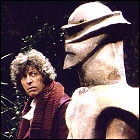 The dying Keeper of the harmonious Union of Traken summons the Doctor to help his world as his reign comes to a close. Normally the Keeper would never summon outside help, but in this case an otherworldly evil is slowly preparing to take control of the Union, and otherworldly help will be needed to defeat it. But as betrayals and complacency allow a malignant alien to assume the Keepership – and with it enormous power – the Doctor is slow to realize that this particular adversary is known to him personally. Though he is able to preserve Traken’s people, the Doctor is unaware that his greatest adversary has gained a new lease on life.
The dying Keeper of the harmonious Union of Traken summons the Doctor to help his world as his reign comes to a close. Normally the Keeper would never summon outside help, but in this case an otherworldly evil is slowly preparing to take control of the Union, and otherworldly help will be needed to defeat it. But as betrayals and complacency allow a malignant alien to assume the Keepership – and with it enormous power – the Doctor is slow to realize that this particular adversary is known to him personally. Though he is able to preserve Traken’s people, the Doctor is unaware that his greatest adversary has gained a new lease on life.
written by Johnny Byrne
directed by John Black
music by Roger LimbGuest Cast: Anthony Ainley (Tremas), Sarah Sutton (Nyssa), Sheila Ruskin (Kassia), Denis Carey (The Keeper), John Woodnutt (Seron), Margot Van De Burgh (Katura), Robin Soans (Luvic), Roland Oliver (Neman), Geoffrey Beevers (Melkur)
Broadcast from January 31 through February 21, 1981
LogBook entry & review by Earl Green
Review: The Union of Traken is one of the most detailed and interesting alien cultures seen in the history of Doctor Who, and in some ways, the Source that provides the Keeper with his power is very similar to the Great Machine of Epsilon 3 in numerous episodes of Babylon 5, though there are numerous hints that the harmony that Traken enjoys is an extension of the will of the sitting Keeper; since the Master is able to force his will onto Kassia, Tremas and even the Doctor, this is not an unreasonable assumption. If this is indeed the case, it’s a wonder that there hadn’t been a corrupt Keeper in Traken’s past – or perhaps there was, and that history has been carefully buried. Now you begin to see why it’s sad that Traken was never visited in later stories, but in any case, the entire Union was destroyed in Logopolis.
Anthony Ainley, who became the Master at the end of part four, was very good as Councillor Tremas, though Sheila Ruskin tended to overdo her role as his wife. Denis Carey’s guest appearances are always welcome, whether on Doctor Who or Blake’s 7 (he previously appeared in Shada, though that story itself failed to appear, and later in 1985’s Timelash), though he is covered in makeup and confined to a chair for most of Traken. And Geoffrey Beevers somehow fails to ooze malevolence as the emaciated Master they way Peter Pratt did in 1976’s Deadly Assassin – the makeup is much less convincing, though this  may have been done to make it less alarmingly horrific, but somehow the character isn’t the same either. The script was also written rather clumsily to conceal the Master’s identity – why would the Master, a Time Lord, refer to the Doctor as “Time Lord” when he is one himself?
may have been done to make it less alarmingly horrific, but somehow the character isn’t the same either. The script was also written rather clumsily to conceal the Master’s identity – why would the Master, a Time Lord, refer to the Doctor as “Time Lord” when he is one himself?
But it’s an enjoyable outing for the far too short-lived pairing of Tom Baker’s Doctor and Matthew Waterhouse as Adric, and it also forms the basis for a much later bit of continuity – the Master can take over someone else’s body, displacing their mind completely and assuming their form permanently. This is vital to the 1996 TV movie’s plot.

